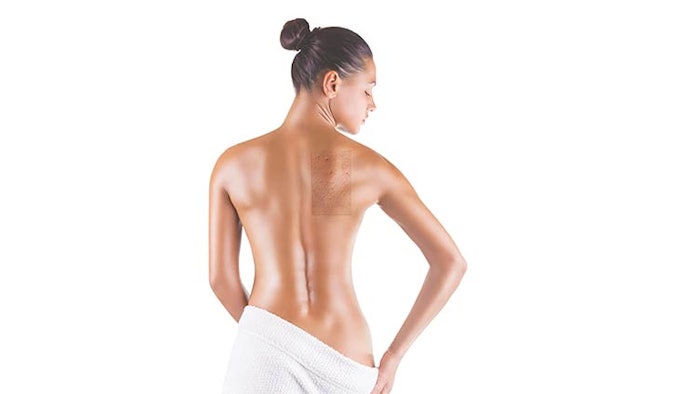
What causes body acne?
Natalie Pergar, lead skin care trainer at Éminence Organic Skin Care: Acne on the body is caused by many of the same factors as facial acne: bacteria, overactive oil glands and excess dead skin cells. Oil and dead skin cells can block pores, mixing with acne-causing bacteria and triggering an immune response that presents as acne. Additional contributing factors include wearing tight-fitting clothing and using dirty shower accessories.
Sandra Friedli, director of education at Biologique Recherche: Body acne is the result of clogged pores due to accumulation of dead skin cells; excess oil production because of a malfunctioning sebaceous gland; and inflammation associated with bacteria. Genetics, hormones, stress and personal hygiene can also contribute to face and body acne.
Jenny Little, lead esthetician at Hiatus Spa + Retreat in San Antonio, Texas: There are more sebaceous glands on the upper half of the body, so those follicles tend to get more clogged with oil and excess skin cells (I know, yuck!). Sweat can also irritate body acne, so it’s important to keep the body clean and free of excess oil. A thorough but gentle cleansing—preferably with a salicylic acid or benzoyl peroxide wash—is better than a more vigorous scrubbing.
Katherine Tomasso, national director of education at Yon-Ka Paris: Hyperactive sebaceous glands and hormonal imbalances are typically the primary causes of acne, but it can also be triggered by other lifestyle factors. For anyone dealing with advanced acne on the face, particularly at the grade 3 or 4 levels, it’s likely that the problem will progress onto the back. But the overall root cause is the same.
Breakouts on the back are often exacerbated by synthetic fragrances and other laundry additives. Many fabric softeners and dryer sheets, for example, contain a waxy softening agent that coats clothing and can also clog the pores, so it’s best to eliminate their use. Friction from tight clothes can cause often-imperceptible breaks in the skin, which allows bacteria to enter and cause a breakout. Furthermore, the type of fabric can also contribute to breakouts, with less breathable fabrics making it easier to trap acne-causing bacteria on the skin.
How can treating body acne be different from treating breakouts on the face?
Pergar: Body breakouts can be more challenging to treat than those on the face. Because hair follicles and pores are spaced further apart, the skin on the body tends to be tougher, meaning that it can be difficult for topical products to penetrate and work as quickly as they do for facial acne. However, the skin on certain areas, for example the back, can be more resilient and less sensitive to potent treatments.
Continue reading the digital magazine for more insight on holistic treatments for body acne...

![[VIDEO] An Osmosis Facial Infusion Treatment Step-by-Step](https://native-x.imgix.net/allured/663137812f619a000179e394/Thumbnail-Sized.jpg?crop=focalpoint&fit=crop&fp-x=0.5&fp-y=0.5&h=191&w=340&auto=format%2Ccompress&q=70)









